experience more

t Romantic Inveraray Castle, with its Gothic and Baroque features
This multi-turreted mock Gothic palace is the family home of the powerful Clan Campbell, the Dukes of Argyll since 1701. Building started in 1746 by architects Roger Morris and William Adam on ruins of a 15th-century castle. The conical towers were added after a fire in 1877.
The magnificent interiors, designed by Robert Mylne in the 1770s, form a backdrop to such treasures as Regency furniture, a huge collection of Oriental and European porcelain and portraits by Ramsay, Gainsborough and Raeburn. The Armoury Hall contains early weaponry collected by the Campbells to fight the Jacobite rebels. The Combined Operations Museum commemorates the 250,000 Allied troops who trained at Inveraray during World War II.
The first open-air museum in Scotland, Auchindrain illuminates the working lives of the kind of farming community typical of the Highlands until the late 19th century. Constituting a township of some 20 thatched cottages, the site was communally farmed by its tenants until the last one retired in 1962. Visitors can wander through the houses, most of which combine living space, kitchen and a cattle shed all under one roof. They are furnished with box beds and rush lamps, and edged by herb gardens. Auchindrain is a fascinating memorial to a time before the Highland farmers made the transition from subsistence to commercial farming.
Did You Know?
The final scenes of the 1963 James Bond film From Russia With Love were filmed around Argyll and Bute.
Considered to be the most beguiling of all the gardens of the West Highlands, the Crarae Gardens were created in 1912 by Lady Grace Campbell. She was the aunt of explorer Reginald Farrer, whose specimens from Tibet were the beginnings of a collection of exotic plants. The gardens now resemble a Himalayan ravine, nourished by the warmth of the Gulf Stream and the high rainfall of the region. Although unusual Himalayan rhododendrons flourish here, the gardens are also home to exotic plants from Tasmania, New Zealand and the US. Great plant collectors still contribute to the gardens, which thrive in late spring.
Barren, mountainous and overrun by red deer, Jura has only one road connecting the single village of Craighouse, home to the Jura Distillery, to the Islay ferry. Though hiking is restricted from July to the end of October during the deer-stalking season, Jura offers superb hill walking, especially on the slopes of the three main peaks known as the Paps of Jura. The tallest of these is Beinn An Oir at 784 m (2,572 ft). Beyond the northern tip of the isle are the notorious whirlpools of Corryvreckan. The author George Orwell, who came to the island to write his final novel, 1984, nearly lost his life here in 1946 when he fell into the water. Legend tells of Prince Breackan who drowned in his attempt to win the hand of a princess. He tried to keep his boat anchored in the whirlpool for three days, held by ropes made of hemp, wool and maidens’ hair, until one rope, containing the hair of an unfaithful girl, finally broke.
Jura Distillery
" ' = ⌂ Craighouse # 10am–4:30pm Mon–Sat (Nov–Mar: 10am–4pm Mon–Fri) ∑ jurawhisky.com
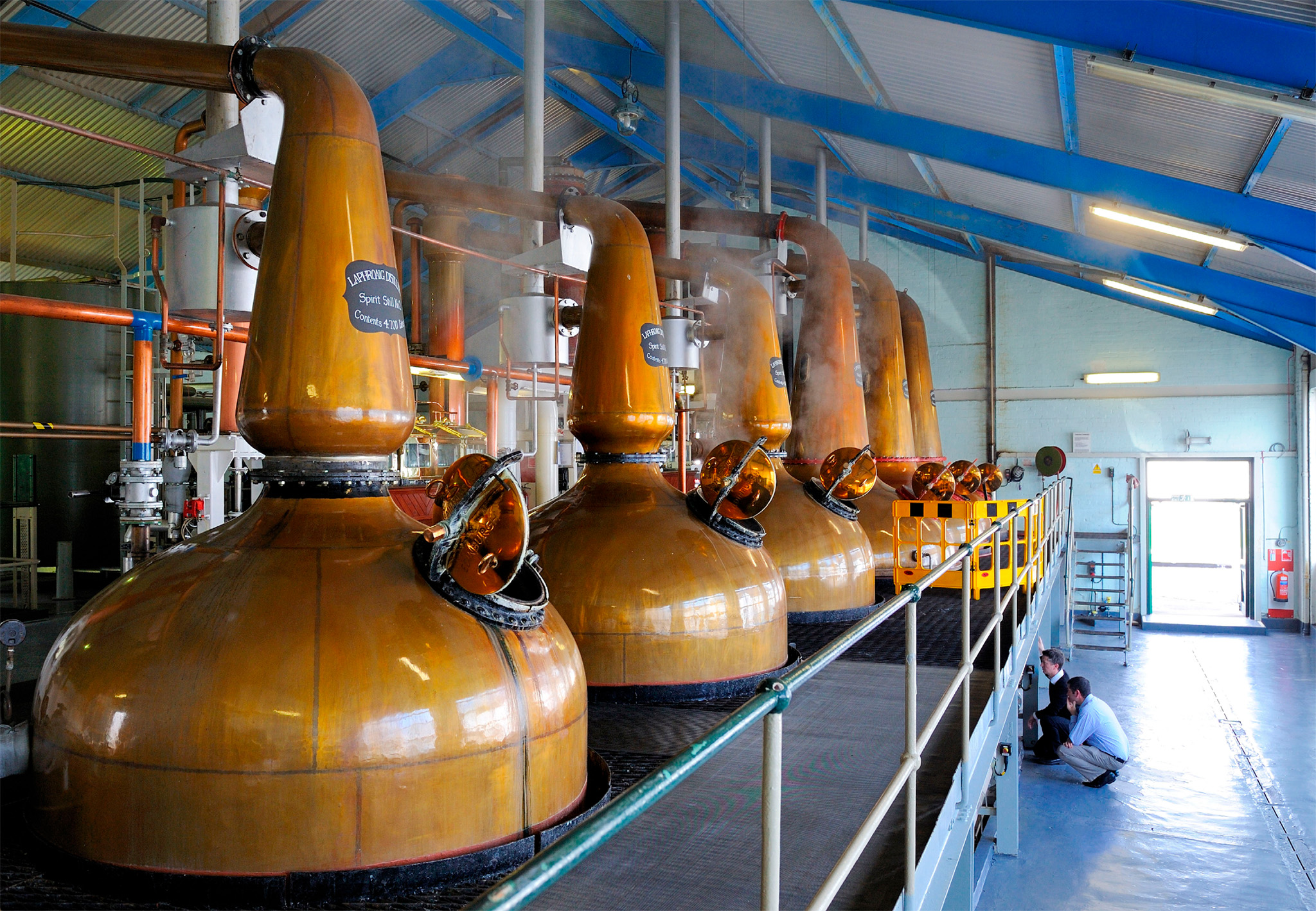
t Copper stills used to make single malt whisky at Laphroaig Distillery, on Islay
The most southerly of the Western Isles, Islay (pronounced “Eyeluh”) is home to such Highland single malt whiskies as Lagavulin and Laphroaig. Most of the distilleries produce heavily peated malts with a distinctive tang of the sea. The Georgian village of Bowmore has the island’s oldest distillery and a circular church designed to minimize the Devil’s possible lurking places. The Museum of Islay Life in Port Charlotte covers the island’s social and natural history. East of Port Ellen, the Kildalton Cross, a block of local green stone inscribed with Old Testament scenes, is one of the UK’s most impressive 8th-century Celtic crosses. Also worth a visit is the medieval stronghold of the Lords of the Isles, Finlaggan, which is under excavation. Some of Islay’s superb beaches support a variety of birdlife, which can be seen at the Royal Society for the Protection of Birds (RSPB) reserve at Gruinart.

t Laphroaig Distillery
Museum of Islay Life
" ⌂ Port Charlotte # 10:30am–4:30pm daily (Apr & Oct: Mon–Fri)
∑ islaymuseum.org

t Serene Artdoe Beach on the northeast side of the Ardnamurchan Peninsula
This peninsula and the adjacent areas of Moidart and Morvern are some of the west coast’s best-kept secrets. They are characterized by a sinuous coastline, rocky mountains and beaches. Some of the best beaches are at the tip of the peninsula, the most westerly point of mainland Britain.
The Ardnamurchan Lighthouse Visitor Centre at Kilchoan explores the history of lighthouses and light-keeping. The 1846 lighthouse was designed by Alan Stevenson, uncle of author Robert Louis Stevenson. It is one of many built by the Stevenson family throughout Britain.
The award-winning Ardnamurchan Natural History Visitor Centre at Glenmore has encouraged wildlife to inhabit its “living building”, and wild red deer can even graze on its turf roof. An enchanting wooded road runs from Salen to Strontian, or head north to Acharacle.
Ardnamurchan Lighthouse Visitor Centre
" ' - ⌂ Kilchoan # Apr–Oct: daily ∑ ardnamurchanlighthouse.com
Ardnamurchan Natural History Visitor Centre
" - = ⌂ Glenmore # 8:30am–5pm Sun–Fri ∑ ardnamurchannaturalhistorycentre.com

t Jagged granite ridges of Arran’s Goatfell Mountains rising high above the island
Arran is thought to have been populated as long ago as the end of the last Ice Age. The island’s Neolithic chambered burial tombs, such as the one at Torrylinn near Lagg in the south, are an indication of this. Bronze Age stone circles can also be seen around Machrie on the west coast. Vikings arrived from about AD 800 and exerted an influence for more than four centuries. After the Battle of Largs in 1263, when Alexander III defeated the Norsemen, Scotland bought Arran from the Vikings in 1266.
Today, visitors tend to come to Arran for outdoor pursuits. Golf is especially popular, with seven golf courses on the island, including 18-hole courses at Brodick, Whiting Bay and Lamlash.
Brodick is the island’s only real town. The more mountainous parts offer some of the most spectacular hill walking in Central Scotland. The Goatfell ridge to the east of Glen Rosa and Beinn Tarsuinn to the west have a rugged beauty.
Robert the Bruce stayed on Arran on his return to Scotland in 1307. His followers had already been harassing the garrison at Brodick Castle, then occupied by supporters of the King of England. Legend states that it was from Arran that Bruce saw a signal fire on the Ayrshire coast that told him it was safe to return to the mainland and launch the campaign against the English. Parts of the Castle still date from the 13th century, though it has had many later additions.
Brodick Castle
" - « ⌂ Brodick § (01770) 302202 # May–Sep: 11am–4pm (Apr & Oct:to 3pm); gardens all year
Bute is almost an extension of the Cowal Peninsula, and the small ferry from Colintraive takes only five minutes to cross the Kyles of Bute to Rhubodach on the island. This route is a long drive from Glasgow, however, and most people travel via Wemyss Bay on the Firth of Clyde to the island’s main town, Rothesay.
Just 25 km (16 miles) long by 8 km (5 miles) at its widest point, Bute has been occupied since at least the Bronze Age. The remains of the chapel at St Ninian’s Point on the west coast date from around the 6th century, while Rothesay Castle, now ruined, is mostly a 12th-century structure. It saw struggles between islanders and Vikings in the 13th century, but over the last 120 years, it has played a more placid role as a holiday resort.
Bute’s main attraction is Mount Stuart House, 5 km (3 miles) south of Rothesay. This aristocratic house, built in 1877, is set in 18th-century gardens. Its Gothic features reflect the Marquess’s interests in mythology, religion and astronomy.
Rothesay Castle
" ⌂ Castle Hill St, Rothesay # Apr–Sep: 9:30am–5:30pm daily; Oct–Mar: 10am–4pm Mon–Wed, Sat & Sun
∑ historicenvironment.scot
Mount Stuart House
" ' - ⌂ Mount St # Apr–Oct: 11am–5pm daily ∑ mountstuart.com

great View
Scotland in Miniature
With mountain walks and serene coastal paths, the isle of Arran has it all. The three-mile Glen Rosa to Brodick walk is one of the best on the island, with a stunning view over the Goatfell mountains.
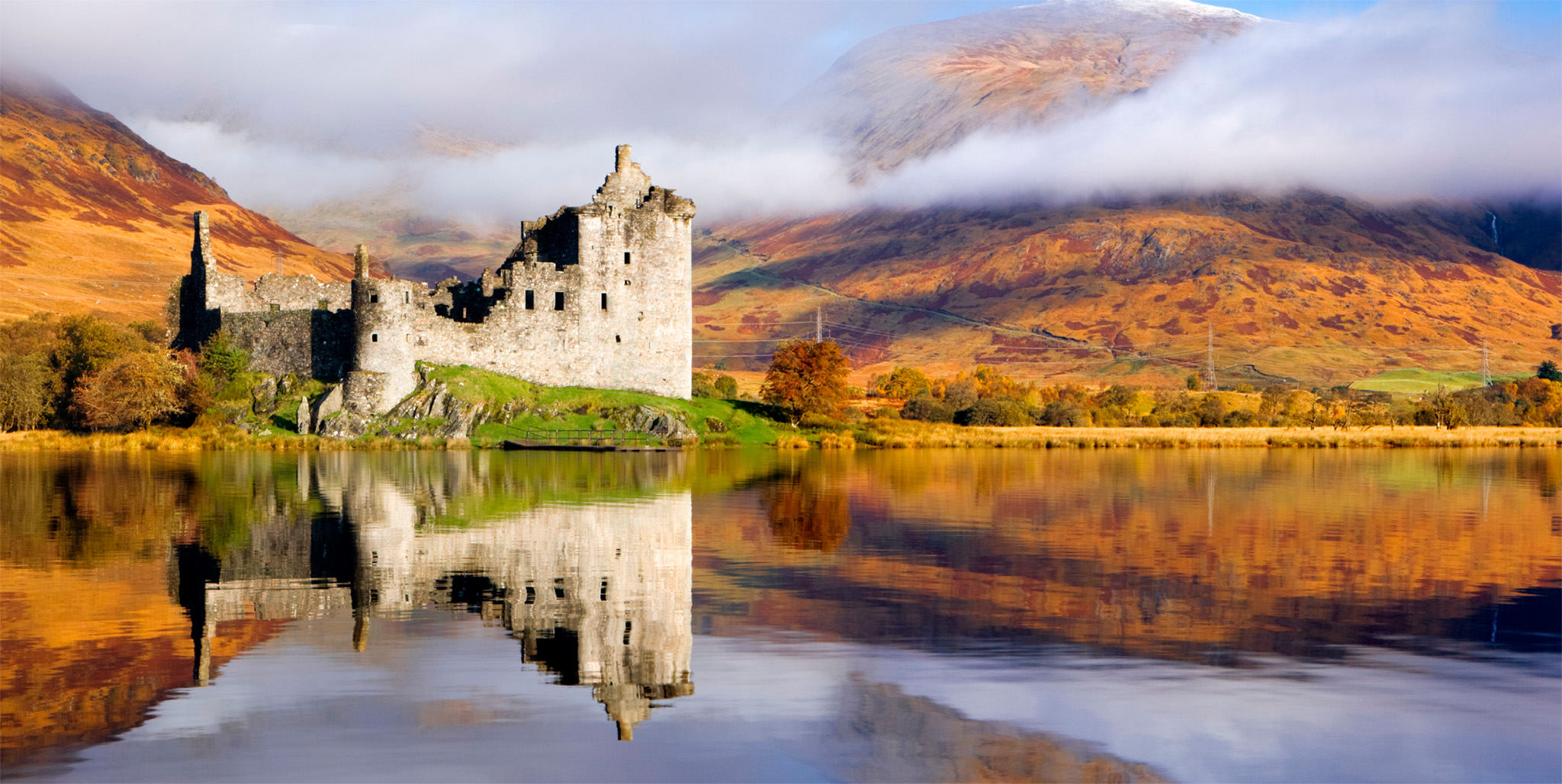
t Kilchurn Castle, on a rocky peninsula on Loch Awe
One of the longest freshwater lochs in Scotland, Loch Awe stretches 40 km (25 miles) across a glen in the southwestern Highlands. A short drive east from the town of Lochawe are the remains of Kilchurn Castle, abandoned after being struck by lightning in the 18th century. Dwarfing the castle is Ben Cruachan. The huge summit of 1,126 m (3,694 ft) can be reached by the narrow Pass of Brander, where Robert the Bruce fought the Clan MacDougal in 1308. Near the village of Taynuilt is the preserved Lorn Furnace at Bonawe, which serves as a reminder of the iron-smelting industry that destroyed much of the area’s woodland in the last centuries.
On the A816, to the south of the loch, is Kilmartin Museum, displaying artifacts from local prehistoric sites, as well as reconstructions of boats, utensils and jewellery, and providing a vivid glimpse into what life was like in prehistoric Scotland.
Kilmartin Museum
" - = ⌂ Kilmartin # Daily
∑ kilmartin.org
Did You Know?
The first transatlantic telephone cable landed at Oban during the Cold War.
A long, narrow peninsula stretching far south of Glasgow, Kintyre has superb views across to the islands of Gigha, Islay and Jura. The 14 km (9 mile) Crinan Canal, which opened in 1801 and has a total of 15 locks, bustles with pleasure craft in the summer. The town of Tarbert (meaning “isthmus” in Gaelic) takes its name from the neck on which it stands, which is narrow enough to drag a boat across, between the waters of Loch Fyne and West Loch Tarbert. This feat was first achieved by the Viking King Magnus Barfud who, in 1198, was granted by treaty as much land as he was able to sail around.
Travel further south past Campbeltown and the B842 road ends at the headland known as the Mull of Kintyre, which was made famous when former Beatle Paul McCartney, who had a home in Kintyre, added lyrics and commercialized a traditional pipe tune of the same name. Westward from Kintyre lies the isle of Rathlin. It is here that Robert the Bruce learned patience in his constant struggles against the English by observing a spider weaving an elaborate web in a cave.
Known as the “Gateway to the Isles”, this bustling port on the Firth of Lorne commands fine views of the Argyll coast. Shops crowd the seafront around the “little bay” which gives Oban its name, and fresh fish is always for sale on the busy pier. Regular ferries leave for Mull, Coll, Tiree, Barra, South Uist, Islay, Colonsay and Lismore, making Oban one of the most-visited places on the west coast. Built on a steep hill, the town is dominated by the immense McCaig’s Tower, an eccentric Colosseum-like structure built in the 1800s. Other major landmarks are the pink granite cathedral and the 600-year-old ruined keep of Dunollie Castle, once the northern outpost of the Dalriadic Scots. Among Oban’s other attractions are working centres for glass and pottery, and Oban Distillery, producers of fine malt whisky. On rainy days a good option is the old-fashioned Oban War and Peace Museum which offers an interesting insight into local culture.
At the end of July yachts converge on the town for West Highland Week, while at the end of the month, Oban’s Highland Games take place. Nearby Kilmore, Taynuilt and Tobermory, on Mull, also host summer Highland Games.
A few miles north of Oban, off the A85, is the 13th-century Dunstaffnage Castle where Flora MacDonald was briefly imprisoned for helping Bonnie Prince Charlie escape in 1746. Further north at Barcaldine is the Scottish Sealife Sanctuary. This centre combines looking after injured and orphaned seals with displays of underwater life. The Isle of Seil is reached
via the 18th-century “Bridge over the Atlantic”. The Easdale Folk Museum, on the tiny island of Easdale off Seil, has displays about the history of slate mining in the area. South of Oban along the coast is Arduaine Garden, noted
for its rare varieties of spring-blooming rhododendrons and colourful azaleas.
Oban War and Peace Museum
⌂ Corran Esplanade # Mar–Nov: daily ∑ obanmuseum.org.uk
Dunstaffnage Castle
" ' ⌂ Connel § (01631) 562465 # Apr–Sep: daily; Oct–Mar: Sat–Wed
Scottish Sealife Sanctuary
" ⌂ Barcaldine, near Connel # Easter–Oct: 10am–5pm daily; Nov–Easter: 11am–4pm Fri–Mon
∑ visitsealife.com
Easdale Folk Museum
⌂ Easdale # Apr–mid-Oct: 11am–4pm daily ∑ easdalemuseum.org
Arduaine Garden
" ' « ⌂ Arduaine § (01852) 200366 # Daily, tours by appointment
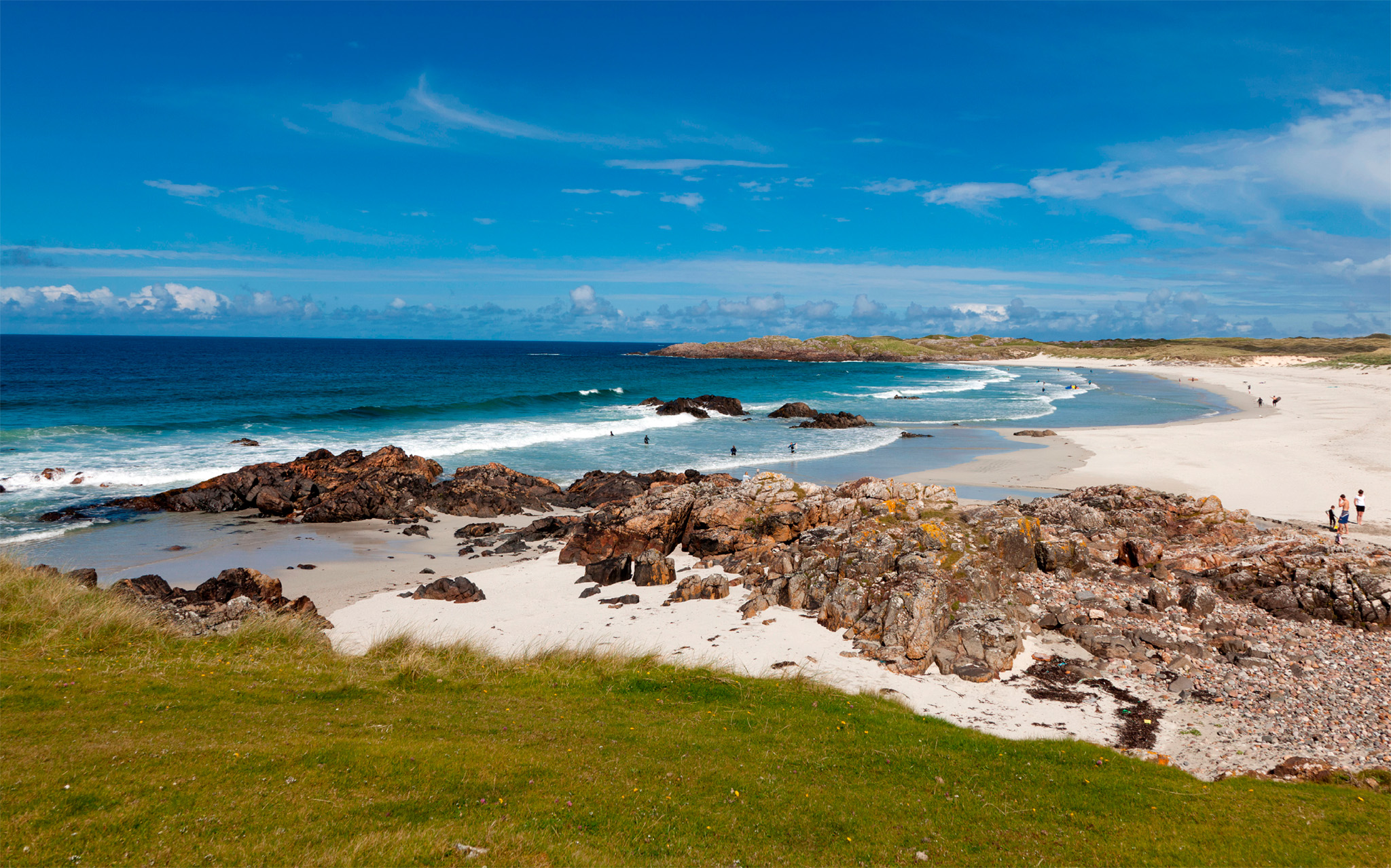
t The beautiful white sands of Balevullin Beach on the windswept island of Tiree
Despite frequent notices of winter gale warnings, these islands, the most westerly in the Inner Hebrides, often record more hours of sunshine than the rest of Britain. They offer beautiful white-sand beaches and impressive surf. Tiree’s soil is 60 per cent shell sand, so no trees can grow. As a result, it is perhaps the windiest place in Scotland. Wild flowers flourish here in spring.
Breacachadh Castle, the 15th-century home of Clan Maclean until 1750, overlooks a bay in south Coll but is not open to the public. Tiree has two free museums, the Trenish Isles Exhibition, about the natural history of this group of islands, visible from Tiree, and the Skerryvore Lighthouse Museum in Hynish. The lighthouse stands 20 km (12 miles) offshore.
The heart of Mallaig is its harbour, which has an active fishing fleet and ferries that serve the Small Isles and Skye. The atmosphere is rather more commercial than leisurely, but it is set in an area of outstanding beauty. The Mallaig Heritage Centre is a local history museum covering fishing, railways, steamers and ferries.
Mallaig Heritage Centre
" ' ⌂ Station Rd # 11am–4pm Mon–Sat ∑ mallaigheritage.org.uk

t European shag perched on a rock on the tiny island of Canna
Each of the four Small Isles has an individual character and atmosphere, but shares a sense of tranquillity. Canna is a narrow island surrounded by cliffs and has a scattering of unworked archaeological sites. Once owned by Gaelic scholar John Lorne Campbell, it now belongs to the National Trust for Scotland. It has very few inhabitants.
Eigg is the most varied island. Dominated by the distinctive sugarloaf hill, the Sgurr of Eigg, it has a glorious beach with “singing sands” that make odd noises when moved by feet or by the wind. Here the islanders symbolize the spirit of community land ownership, having successfully led a campaign to buy their island from their landlord.
Muck takes its name from the Gaelic for “pig”, which it is said to resemble in shape. The smallest of the islands, but no less charming, it is owned by a family who live and farm on the island. Rum is the largest and most magnificent island, with scabrous peaks that are home to an unusual colony of Manx shearwater birds. The island’s rough tracks make it best suited to the active visitor. Now owned by Scottish Natural Heritage and a centre for red deer research, it previously belonged to the wealthy Bullough family. They built the lavish Kinloch Castle whose design and furnishings were revolutionary at the time. It has fallen into disrepair, but a group is assessing how to provide a sustainable future for it.
Kinloch Castle
⌂ Rum ∑ kinlochcastlefriends.org
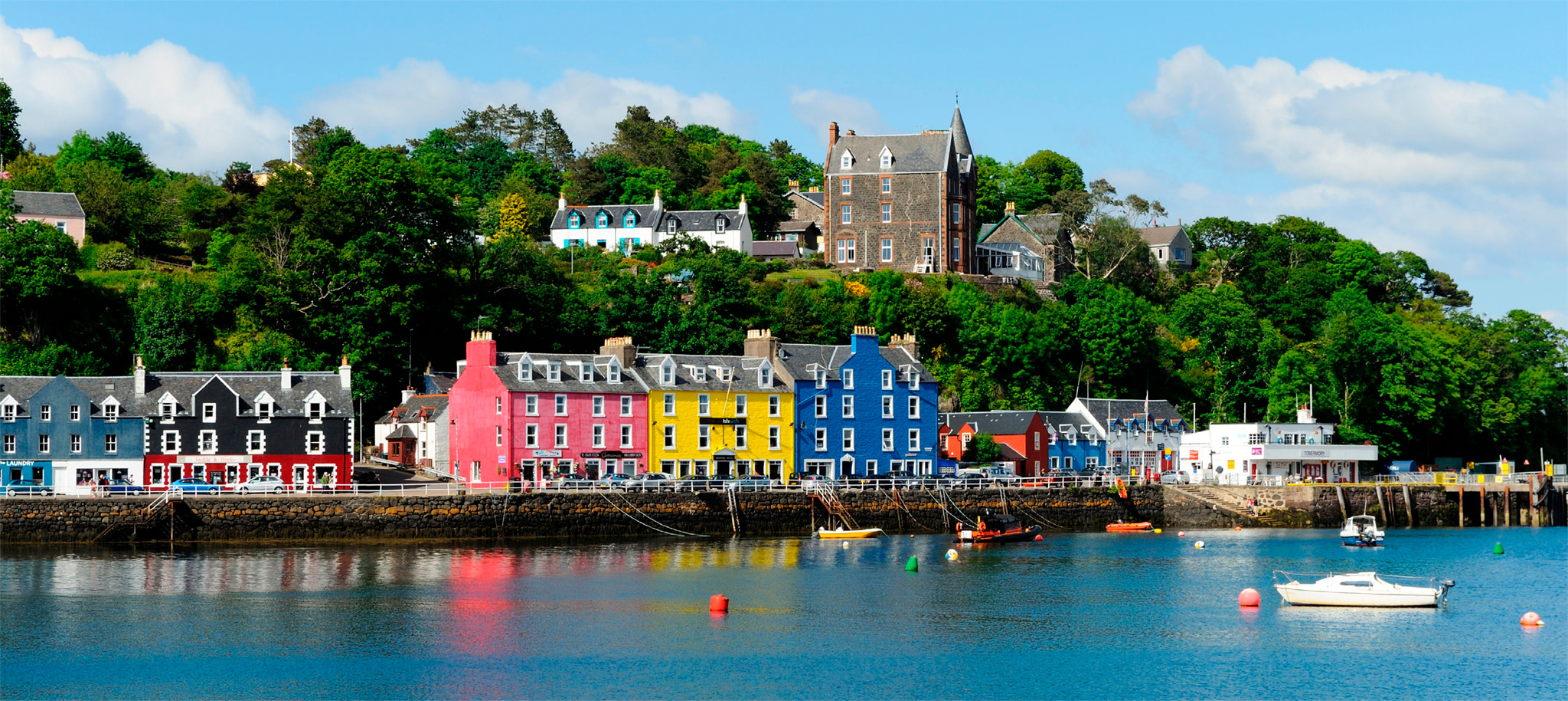
t Brightly coloured buildings line the street on Tobermory Harbour
The largest of the Inner Hebridean islands, Mull features rough moorlands, the rocky peak of Ben More and a splendid beach at Calgary. Most roads follow the coastline, affording wonderful sea views.
On a promontory to the east of Craignure lies the 13th-century Duart Castle, home of the chief of Clan Maclean. You can visit the Banqueting Hall, State Rooms and the dungeons that once held prisoners from a Spanish Armada galleon, sunk in 1588 by one Donald Maclean.
At the northern end of Mull is the picturesque town of Tobermory, with its brightly coloured buildings and a kaleidoscope of houses along the seafront. Built as a fishing village in 1788, it is now a popular port for yachts, and one of Mull’s most favoured tourist stops. The harbourside Mull Aquarium is Europe’s first catch and release aquarium. With its touch pools and cinema, it holds great appeal for kids.
The small and very beautiful island of Iona is one of the biggest attractions on Scotland’s west coast. A restored abbey stands on the site where Irish missionary St Columba began his crusade in 563 and made Iona the home of Christianity in Europe. In the graveyard of the abbey, 48 Scottish kings are said to be buried and four historic high crosses can be seen, two of them along the medieval Street of the Dead. Since 1938, when the Iona Community was formed, this has again been a religious centre. During the summer months the abbey has a large influx of visitors.
If you are lucky with the weather, head to Fingal’s Cave on the Isle of Staffa. A true natural wonder, the cave is surrounded by “organ pipes” of basalt, the inspiration for Mendelssohn’s Hebrides Overture (1833). Boat trips run there from Ulva and Fionnphort and to the seven Treshnish Isles. These uninhabited isles are a sanctuary for thousands of seabirds, including puffins, razorbills, kittiwakes and skuas. Lunga is the main stop for tour boats.
Duart Castle
" - = ⌂ Off A849, near Craignure # Apr: 11am–4pm Sun–Thu; May–Oct: 10:30am–5pm daily
∑ duartcastle.com
Mull Aquarium
⌂ Taigh Solais, Tobermory # Easter–Oct: 9:30am–5pm daily
∑ mullaquarium.co.uk
Fingal’s Cave and Treshnish Isles
" ⌂ Staffa, west of Mull 4 Easter–Oct # Timetable varies, check website ∑ staffatours.com

Picture Perfect
Tobermory Harbour
For that iconic snap of Tobermory’s colourful waterfront, head to the aquarium end of Main Street. A lookout point here offers an excellent shot of the harbour, twinkling with the reflections of brightly coloured buildings.
Experience The Highlands and Islands
|
EAT Café Fish Super-fresh seafood straight off the boat, and a surprising wine list are on offer here. There’s a quayside terrace in summer. B5 ⌂ The Pier, Tobermory, Mull ∑ thecafefish.com ]]] Tea Garden Café For real home cooking, look no further. This quirky café is famed for its pint of prawns, fresh from the harbour. B4 ⌂ Mallaig Backpackers Lodge, Station Rd, Mallaig ∑ mallaigbackpackers.co.uk ]]] Argyll Hotel Crofters and local fishermen keep this cosy restaurant well-stocked with lamb, game, beef and seafood. B5 ⌂ Isle of Iona, Argyll ∑ argyllhoteliona.co.uk ]]] |
Renowned for its awesome scenery and savage history, Glencoe was compared by Dickens to “a burial ground of a race of giants”. The precipi-tous cliffs of Buachaille Etive Mor and the knife-edged ridge of Aonach Eagach offer a formidable challenge even to experienced mountaineers. Against a backdrop of craggy peaks and the tumbling River Coe, the Glen offers superb hill walking. The Visitor Centre has details of routes, ranging from an easy walk near Signal Rock (from which the signal was given for the massacre) to a stiff 10-km (6-mile) haul up the Devil’s Staircase. Guided walks are offered in summer by NTS Rangers. East of Glencoe lies Rannoch Moor, one of the emptiest areas in Britain. Take the chairlift at the Glencoe Mountain resort for a dramatic view.
To the southwest, beautiful Glen Etive leads to the head of impressive Loch Etive, which emerges on the coast at the Connel Bridge north of Oban. At the Ballachulish Bridge a side road branches to Kinlochleven, at the head of a long attractive loch.
Glencoe Mountain
" ⌂ Kingshouse, Glencoe # Daily ∑ glencoemountain.co.uk
Experience The Highlands and Islands
Massacre of Glencoe
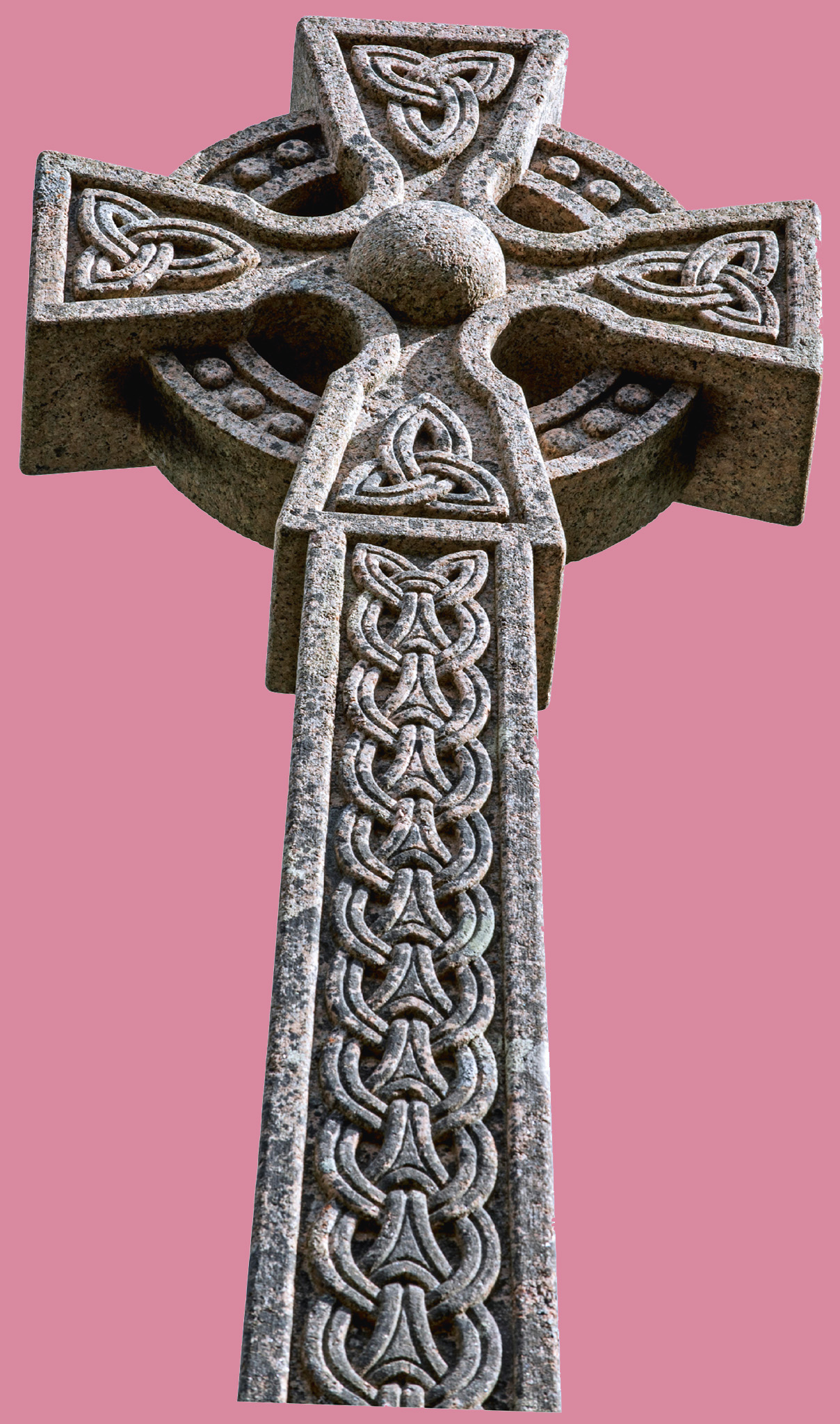
In 1692, the Glencoe MacDonalds chief was five days late with an oath of submission to William III, providing an excuse to root out a nest of Jacobite supporters. For ten days 130 soldiers, under Robert Campbell, were hospitably entertained by the MacDonalds before, in a terrible breach of trust, the soldiers turned on them and killed them. A political scandal ensued, but there were no official reprimands for three years.
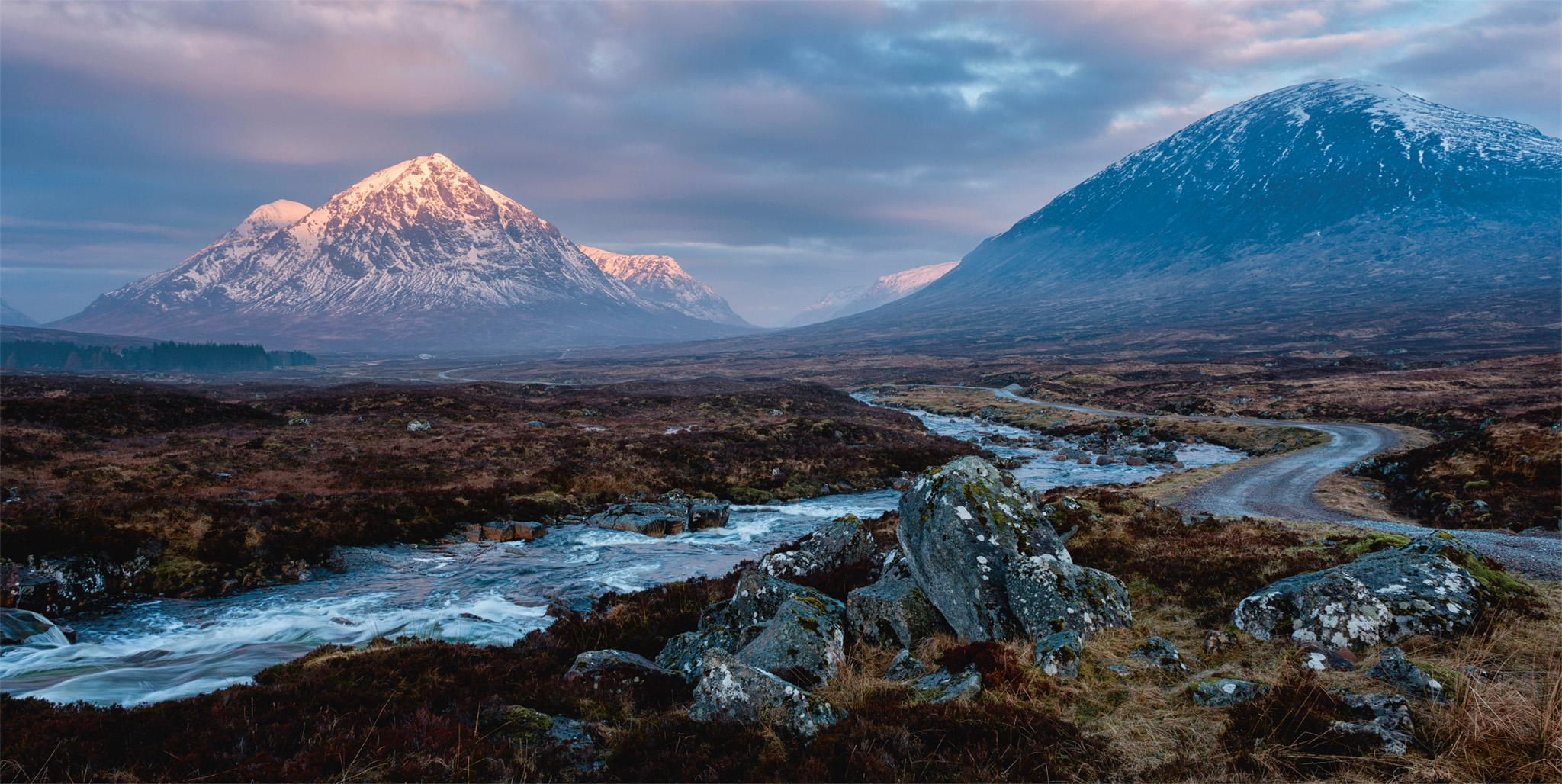
t The vast wilderness of Rannoch Moor and Schiehallion in the distance
Curlews call and buzzards mew as they circle above this desolate expanse of wet and wild moorland, dotted with ponds, rivers and small lochs. In the shadow of the summit of Schiehallion, Rannoch moor is home to an abundance of wildlife, including herds of wild deer. The Black Wood of Rannoch clothes the mountain’s lower slopes, and Alpine flora left by the last Ice Age flourish on the bare rocky slopes of 1,214-m (3,983-ft) Ben Lawers.
Fort William, one of the major towns on the west coast, is noted not for its looks but for its convenient location at the foot of Ben Nevis. The Jacobite Steam Train, which doubles as the Hogwarts Express, runs the magical route from here to the coastal town of Mallaig.
Jacobite Steam Train
3 Fort William# Departs 10:15am & 2:30pm (Apr, May: Mon–Fri; Jun–Sep: daily)
∑ westcoastrailways.co.uk
This rambling, turreted castle has been altered so often in its 700-year history that it now provides a unique insight into the history and changing tastes of aristocratic life in the Highlands. The elegant 18th-century wing displays the gloves and pipe of Bonnie Prince Charlie, who came to gather support for a Jacobite uprising. Family portraits span 300 years and include paintings by such masters as Johann Zoffany and Sir Peter Lely. Sir Edwin Landseer’s Death of a Hart in Glen Tilt (1850) also features.
In 1844 Queen Victoria conferred on its owners, the Dukes of Atholl, permission to maintain a private army, the existing Atholl Highlanders.
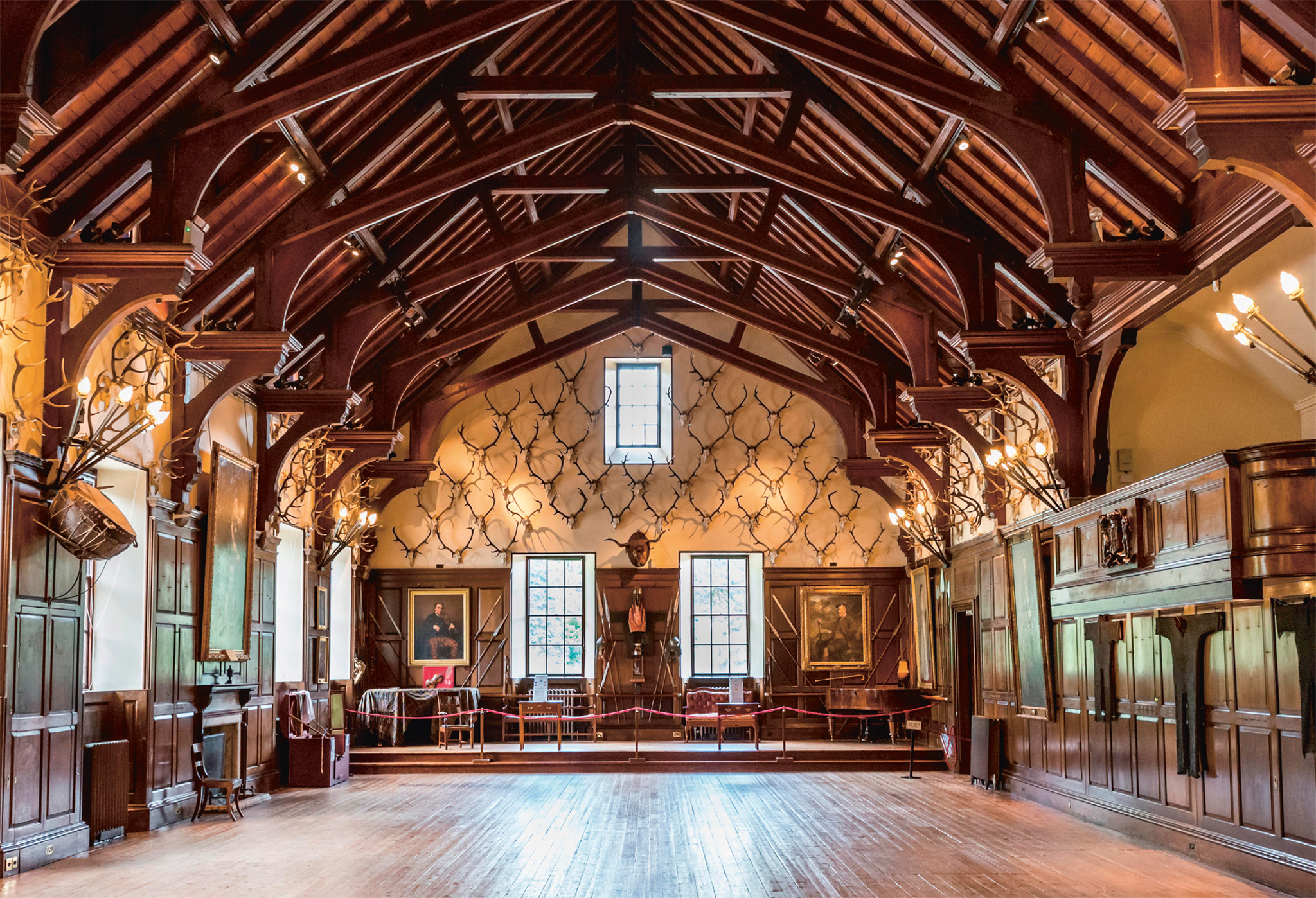
t Blair Castle’s grand ballroom, built for the Atholl Highlanders
Surrounded by beautiful pine-forested hills, Pitlochry became famous after Queen Victoria called it one of the finest resorts in Europe. In early summer, wild salmon leap up the ladder at the Power Station Dam to spawn upriver. Above the ladder are fine views of Loch Faskally, popular with anglers. Walking trails from here link with the pretty gorge at Killiecrankie. Blair Athol Distillery offers guided tours, while the Festival Theatre in Port-na-Craig has shows all year.
Blair Athol Distillery
" ' = ⌂ Perth Rd # Daily
∑ malts.com
Festival Theatre
" ' - ⌂ Port-na-Craig # Mid-May–Oct: daily for plays
∑ pitlochryfestivaltheatre.com
Experience The Highlands and Islands
|
STAY Corrour Station House With no road access, this remote station guesthouse, reached by foot or rail, is perfect for a weekend getaway. C4 ⌂ Corrour Estate, near Fort William # Mid-Mar–Oct ∑ corrour.co.uk ]]] |
For centuries Killiecrankie, site of a famous battle in 1689, was a staging-post between lowland Scotland and the Highlands. Now it’s a peaceful suburb of Pitlochry, and the starting point for a pleasant walk through the scenic Pass of Killiecrankie.
In the Highlands, all roads lead to the region’s “capital”, Inverness. Despite being the largest city in the north, the atmosphere is more townlike, with a compact and easily accessible centre. Although it is sadly defaced by modern architecture, Inverness is known for its floral displays in summer, and for the River Ness, frequented by salmon fishermen during the summer, even where it runs through the city centre. On high ground above the city is Inverness Castle, a Victorian building now used as the courthouse. Nearby, next to the tourist information office, is the Museum and Art Gallery, with permanent and touring exhibitions. The main shopping area fans out in three directions and includes a lively pedestrian precinct with busking musicians.
Just across the river is the Scottish Kiltmaker Visitor Centre. Here visitors get an insight into the history, culture and tradition of the kilt, with audio-visual and workshop presentations of kiltmaking. On the banks of the Ness, Eden Court Theatre has a varied programme of local and international performers. Following the tree-lined banks of the river further upstream and crossing a pedestrian bridge leads to the Island Walks. Beyond this, further upstream still, is Inverness Leisure, with swimming pools, spas and a variety of wild, spiralling flumes. Thomas Telford’s Caledonian Canal, an engineering marvel constructed between 1804 and 1822, is still in constant use and can be viewed at Tomnahurich Bridge. From here, Jacobite Cruises runs various summer cruises along the length of Loch Ness – an excellent way to spend a sunny afternoon. Inverness is an ideal base for touring the rest of the Highlands, as it lies within easy reach of most of the region’s popular attractions, including the Culloden battlesite, 8 km (5 miles) to the east.

t Urquhart Castle ruins overlooking the still waters of Loch Ness
Museum and Art Gallery
- ⌂ Castle Wynd # Apr–Oct: Tue–Sat; Nov–Mar: Thu–Sat
∑ highlifehighland.com
Scottish Kiltmaker Visitor Centre
" ⌂ 4–9 Huntly St # Daily
∑ highlandhouseoffraser.com
Eden Court Theatre
" ' ⌂ Bishop’s Rd
∑ eden-court.co.uk
Inverness Leisure
" ⌂ Bught Lane § (01463) 667500 # Daily
Jacobite Cruises
" ⌂ Tomnahurich Bridge, Glenurquhart ∑ jacobite.co.uk
Highland Clearances
During the heyday of the clan system, tenants paid their land-holding chieftains rent in the form of military service. However, with the destruction of the clan system after the Battle of Culloden, landowners began to demand a financial rent, which their tenants were unable to afford, and the land was gradually bought up by Lowland and English farmers. In what became known as “the year of the sheep” (1792), thousands of tenants were evicted, sometimes forcibly, to make way for live stock. Many emigrated to Australia, America and Canada. The ruins of their crofts can still be seen, especially in Sutherland and Wester Ross.
The broad peninsula of the Black Isle is largely farmland and fishing villages. The town of Cromarty was an important 18th-century port and many of its merchant houses still stand. The museum in the Cromarty Courthouse runs tours of the town. The Hugh Miller Museum recalls the life of theologian and geologist Hugh Miller (1802–56). Fortrose has a ruined 14th-century cathedral, while a stone on Chanonry Point commemorates the Brahan Seer, burnt alive by the Countess of Seaforth after he foresaw her husband’s infidelity. For local archaeology, visit Rosemarkie’s Groam House Museum.
Cromarty Courthouse
" ⌂ Church St, Cromarty # Apr–mid-Oct: noon–4pm Sun–Thu; mid-Oct–Apr: by appointment ∑ cromarty-courthouse.org.uk
Hugh Miller Museum
" = « ⌂ Church St, Cromarty # Mid-Mar–Sep: 1–5pm daily
∑ nts.org.uk
Groam House Museum
" ⌂ High St, Rosemarkie # Apr–Oct: 11am–4:30pm Mon–Fri, 2–4:30pm Sat & Sun ∑ groamhouse.org.uk
Did You Know?
The Moray Firth dolphins are the biggest bottlenose dolphins in the world.
Renowned for its wildlife-spotting opportunities, most notably from popular spot Chanonry Point, the Moray Firth is home to a wealth of marine life. Harbour seals, porpoises, white-beaked and bottlenose dolphins and several species of whale, all come here to feed. Learn more about the Moray Firth’s resident and visiting sealife at the WDC Scottish Dolphin Centre at Spey Bay. Dolphin spotting tours are available.
WDC Scottish Dolphin Centre
" - = ⌂ Spey Bay, Fochabers, Moray # Times vary, check website ¢ Dec–Feb
∑ dolphincentre.whales.org

t Dolphins playing in the Moray Forth, best seen off Chanonry Point
One of the finest examples of European military architecture, Fort George holds a commanding position on the Moray Firth. Completed in 1769, it was built after the Jacobite risings to discourage further rebellion, and is still a military garrison.
The Regimental Museum of the Highlanders Regiment is in the Fort, and some barrack rooms show the conditions of common soldiers more than 200 years ago. The Grand Magazine contains an outstanding collection of arms and military equipment. Fort George’s battlements also offer views of dolphins playing in the Moray Firth.
The desolate battlefield of Culloden looks much as it did on 16 April 1746, when the last battle was fought on British soil. Here the Jacobite cause, under Bonnie Prince Charlie’s leadership, perished from the attack of nearly 9,000 troops, led by the Duke of Cumberland. Visitors can roam the battlefield, visit the clan graves and experience the audio-visual displays at the NTS Visitor Centre.
Roughly 1.5 km (1 mile) east of Culloden are the outstanding Neolithic burial sites at Clava Cairns.
NTS Visitor Centre
" - = ⌂ On the B9006# Daily
∑ nts.org.uk

t The Black Water tumbling over Rogie Falls, Ross-shire
Standing 8 km (5 miles) east of the Rogie Falls, the holiday centre of Strathpeffer still retains the refined charm that made it well known as a Victorian spa and health resort. The town’s huge hotels and gracious layout recall the days when European royalty and lesser mortals flocked to the chalybeate- and sulphur-laden springs, believed to alleviate tuberculosis. It is still possible to sample the water at the unmanned Water Tasting Pavilion found in the town centre.
Water Tasting Pavilion
⌂ The Square # Easter– Oct: daily
With its turreted central tower, moat and drawbridge, Cawdor Castle is one of the Highlands’ most romantic stately homes. Though the castle is famed for being the 11th-century home of Shakespeare’s tragic character Macbeth, and the scene of his murder of King Duncan, it is historically unproven that either figure came here.
An ancient holly tree preserved in the vaults is said to be the one under which, in 1372, Thane William’s donkey stopped for a rest during its master’s search for a place to build a fortress. According to legend, this was how the site for the castle was chosen. Now, after 600 years of continuous occupation (it is still the home of the Thanes of Cawdor) the house contains a number of rare tapestries and portraits by the 18th-century painters Joshua Reynolds (1723–92) and George Romney (1734–1802). Furniture in the Pink Bedroom and Woodcock Room includes work by the 18th-century designers Chippendale and Sheraton. In the Old Kitchen, the huge Victorian cooking range stands as a shrine to below-stairs drudgery. The castle grounds provide beautiful nature trails, as well as a nine-hole golf course.
Experience The Highlands and Islands
|
Stay Culgower House Between Brora and Helmsdale, on the East Sutherland coast, this quaint family home is nestled in wooded hills. Rooms have sea views and breakfasts are a dream. D3 ⌂ Loth, Helmsdale ¢ Nov–Feb ∑ culgowerhouse.com ]]] Beach Cottage Watch dolphins swim in the Moray Firth from this beautifully renovated 18th-century fisherman’s cottage with stunning sea views. D3 ⌂ Stafford St, Helmsdale ∑ bannockburninn.co.uk ]]] |
With its first-class golf course and extensive sandy beaches, Dornoch is a popular holiday resort, but it has retained a peaceful atmosphere. The medieval cathedral (now serving as the parish church) was all but destroyed in a clan dispute in 1570; it was eventually restored in the 1920s for its 700th anniversary. More recently, the American singer Madonna chose the cathedral for the christening of her son and for her own wedding in 2000.
A stone at the beach end of River Street marks the place where Janet Horne, the last woman to be tried for witchcraft in Scotland, was executed in 1722.
Nineteen kilometres (12 miles) to the northeast is the stately, Victorianized pile of Dunrobin Castle, magnificently situated in a great park with formal gardens over-looking the sea. Since the 13th century this has been the seat of the Earls of Sutherland. Many of its rooms are open to visitors.
The peaceful town of Tain to the south became an administrative centre for the Highland Clearances, when the tolbooth was used as a jail. All is explained in the heritage centre, Tain Through Time.
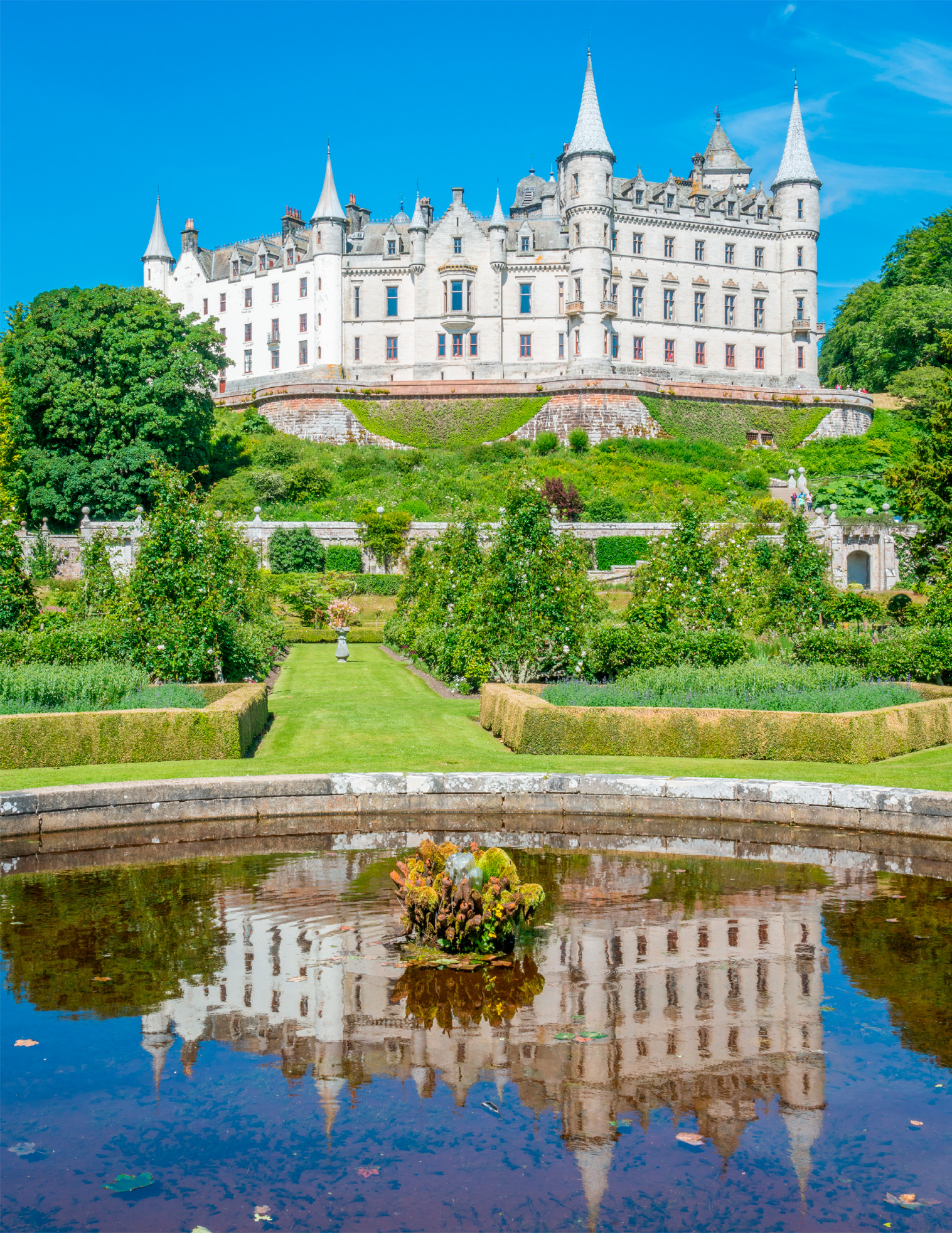
t Dunrobin Castle, seat of the Earls of Sutherland since the 13th century
Dunrobin Castle
" ' - = ⌂ Near Golspie § (01408) 633177 # Apr–mid-Oct: daily
Tain Through Time
" ⌂ Tower St # Jun–Aug: Mon–Sat; Apr, May & Sep: Mon–Fri
∑ tainmuseum.org.uk

Insider tip
Panning for Gold
You can pan for gold in Helmsdale’s Kildonan Burn, where a lucky few sometimes find a pinch of this precious metal. Rent the necessary equipment from Strath Ullie Crafts.
Founded by Vikings, Helmsdale was settled in the 19th century by crofters turfed off their land by the Duke of Sutherland. A flotilla of fishing boats crewed by their descendants still bobs in a harbour surrounded by neat stone houses. The Timespan Heritage Centre tells the story of Helmsdale’s fascinating history and of the gold rush that followed the discovery of small amounts of the precious metal in the Helmsdale River in 1868. The Emigrants Statue commemorates the many people who fled Scotland and sailed to far-off lands in search of a better life during the Highland clearances.
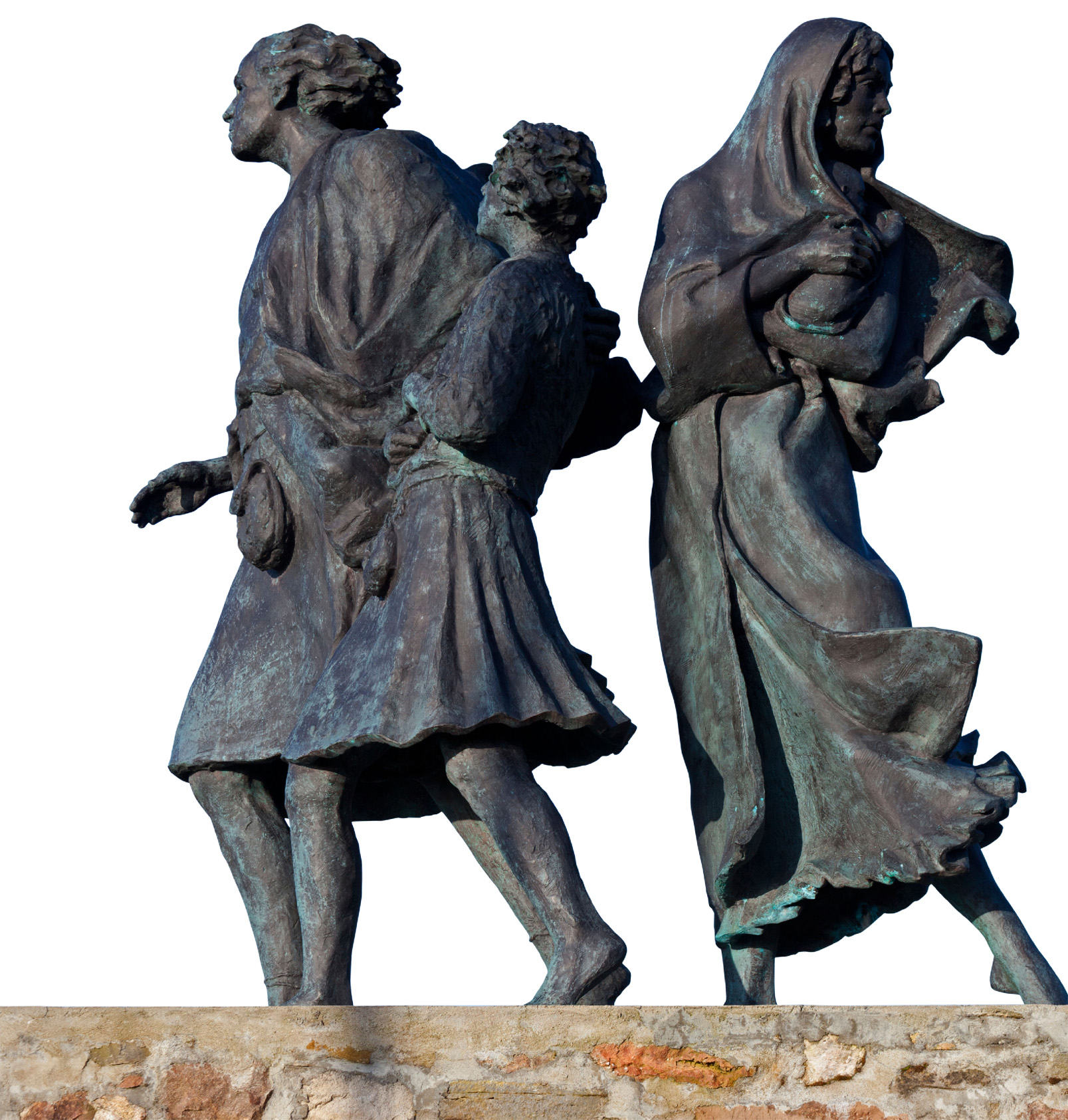
t Helmsdale’s Emigrants Statue commemorating Scottish diaspora
Timespan Heritage Centre
" ' - ⌂ Dunrobin St # 10am–5pm daily ∑ timespan.org.uk

t Eilean Donan Castle amid the stunning scenery of Glen Shiel
Dominating one of Scotland’s most haunting regions, the awesome summits of the Five Sisters of Kintail rear into view as the A87 enters Glen Shiel. The Visitor Centre at Morvich offers ranger-led excursions in summer. Further west is the romantic Eilean Donan Castle. After becoming a Jacobite stronghold, it was destroyed in 1719 by English warships. Restored in the 19th century, it now contains Jacobite relics.
Eilean Donan Castle
" - = ⌂ Off A87, near Dornie # Feb–Dec: daily
∑ eileandonancastle.com
Leaving Loch Carron to the south, the A890 suddenly enters the northern Highlands and the great wilderness of Wester Ross. The sprawling Torridon Estate includes some of the oldest mountains on earth (Torridonian rock is over 600 million years old), and is home to red deer, wildcats and wild goats. Peregrine falcons and golden eagles nest in the towering sandstone mass of Beinn Eighe, above Torridon village, with its breathtaking views over Applecross towards Skye. The Torridon Countryside Centre offers guided walks in season.
Further north, the A832 cuts through the Beinn Eighe National Nature Reserve, Britain’s oldest wildlife sanctuary. Remnants of the ancient Caledonian pine forest still stand on the banks and isles of Loch Maree, sheltering wildcats and pine martens. Buzzards and golden eagles nest above. Beinn Eighe Visitor Centre has informa-tion on the reserve.
Along the coast, a series of exotic gardens thrive in the warming influence of the Gulf Stream. The most impressive is Inverewe Garden.
Torridon Countryside Centre
' « ⌂ Torridon § (01445) 791368 # Apr–Sep: Sun–Fri
Beinn Eighe Visitor Centre
⌂ Near Kinlochewe, on A832 # Mar–Oct: daily ∑ nnr.scot
Just off Scourie on the west coast, this small island is an important breeding sanctuary for many species of seabirds.
In past centuries its hardy people had their own queen and parliament, but the last few were evacuated in 1847 when their potato crop failed. The island was also a burial ground as it was safe from the wolves on the mainland.
The island is now managed by the Scottish Wildlife Trust. Visitors can walk to the 100-m- (328-ft-) high northern cliffs to experience the intimidating antics of great and Arctic skuas (large migratory birds) swooping low over their head. Early in the year 11,000 pairs of razorbills and 66,000 pairs of guillemots take up residence.
Britain’s highest waterfall is Eas Coul Aulin, at 180 m (590 ft), best seen from a tour boat out of Kylesku, 24 km (15 miles) to the south of Handa.

t Puffins are just some of the many species found on Handa Island
Over 130,000 visitors a year come to this national treasure. The gardens contain an extraordinary variety of trees, shrubs and flowers from around the world, despite its latitude of 57.8° north.
Inverewe was started in 1862 by 20-year-old Osgood Mackenzie after he was given a large estate of exposed, barren land next to his family’s holding. He began by planting shelter trees then created a walled garden using imported soil. He found that the climate, warmed by the North Atlantic Drift from the Gulf Stream, encouraged growth of exotic species.
By 1922, it had achieved international recognition as one of the great plant collections, and in 1952 was donated to the National Trust for Scotland. Now one of Scotland’s leading botanical gardens, Inverewe has Blue Nile lilies, the tallest Australian gum trees in Britain and rhododendrons from China. There’s colour all year, but the gardens are at their best between spring and autumn.
With its wide streets, whitewashed houses, palm trees and street signs in Gaelic, this is one of the west coast’s prettiest villages. Built as a fishing station in 1788, it’s on a peninsula jutting into Loch Broom. Fishing is now only important in the winter, when East European “klondyker” factory ships moor in the loch. The major activity is the ferry to Stornoway on Lewis. The Ullapool Museum gives insight into local history.
Ullapool Museum
" ' ⌂ 7–8 West Argyle St # Apr–Oct: Mon–Sat ∑ ullapoolmuseum.co.uk
The northern edge of mainland Scotland encompasses the full variety of Highland geography, from mountainous moorlands and white beaches to flat, green farmland.
Cape Wrath is alluring not only for its name but for its cliffs and its many sea stacks, swarming with sea-birds. In summer, the 13-km (8-mile) road leading to Cape Wrath is served by mini-bus, reached only by taking a ferry from the pier by the Cape Wrath Hotel.
At Durness is Smoo Cave, an awesome cavern hollowed out of limestone. Smoo Cave Tours run trips there. Just outside the town, a small community of artists has established the Balnakeil Craft Village, displaying pottery, wood carving, enamelwork, printmaking and paintings. Astonishingly white beaches follow along the coast, and the road then loops round Loch Eriboll, the deepest of Scotland’s many sea lochs.
The Strathnaver Museum in Bettyhill explains the notorious Sutherland Clearances, the forced evictions of 15,000 people. At Rossal, 16 km (10 miles) south, a walk around an excavated village offers information on life in pre-Clearance days.
The main town here is Thurso, site of Northlands, the Scottish Nordic Music Festival each September.
John O’Groats is probably the most famous name on the map here, said to be the very tip of the mainland, although this is in fact nearby Dunnet Head. Even more rewarding are the cliffs at Duncansby Head and the Pentland Firth.
Smoo Cave Tours
" ⌂ Durness # Apr–Sep: daily ∑ smoocavetours.weebly.com
Strathnaver Museum
" ⌂ Clachan, Bettyhill # Apr–Oct: Mon–Sat ∑ strathnavermuseum.org.uk
Did You Know?
The most northerly point of mainland Great Britain is Dunnet Head, not John o’Groats.
